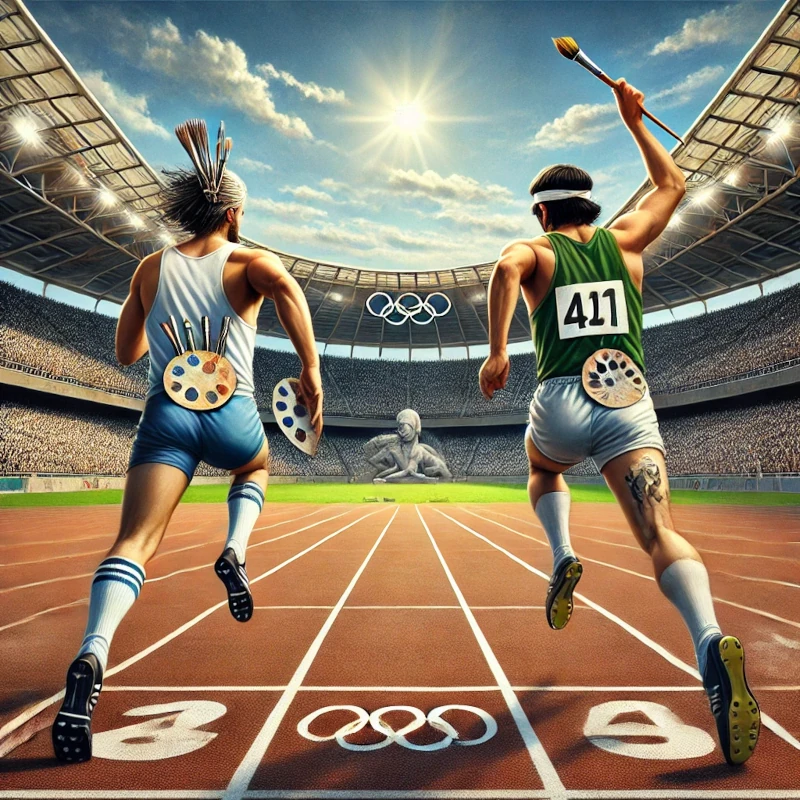Since the start of the modern Olympic Games in 1896, over 130 different sports have been contested. While most people are familiar with staples like gymnastics, track and field, and swimming, they may be surprised to learn about some of the unique events that have come and gone, such as tug-of-war and live pigeon shooting. Additionally, between 1912 and 1952, the Olympics included various art competitions. During these forty years, over 150 medals were awarded in fine arts disciplines, with the sole requirement that each submission be inspired by athletic themes.
The inclusion of art in the early modern Olympic Games can be traced to ancient Greece, where sport and art were closely intertwined. The Greeks believed that exercising both body and mind was essential to achieving harmony. From 776 BCE to 393 CE, the Olympic program included not only sports like running, jumping, boxing, and chariot racing but also competitions in art, music, and heraldry. For the Greeks, sport and art shared a direct connection—music, for instance, was used to improve military coordination and movement.
Baron Pierre de Coubertin, the French visionary who revived the Olympics in the 1890s, strongly advocated for the arts as part of the modern Games. According to Richard Stanton, author of The Forgotten Olympic Art Competitions, Coubertin was classically educated and deeply influenced by the concept of the “true Olympian” as a person skilled not only in athletics but also in music and literature. He believed that the modern Olympics would be incomplete without incorporating some form of artistic expression.
This idea took root during the IV Olympic Congress in Paris in May 1906, where Coubertin encouraged the International Olympic Committee (IOC) to explore how art and literature could be integrated into the modern Games.
Eventually, the IOC selected five art forms for Olympic competition: architecture, literature, music, painting, and sculpture. A condition for entry required each work to be inspired by sport. It took Coubertin several years of negotiation to make this vision a reality. Unlike sports, art was not seen as inherently competitive but rather as a means of intellectual and spiritual enrichment. There were also logistical challenges. As Sweden prepared to host the V Olympiad in 1912, the Swedish Games Committee initially resisted the inclusion of arts, viewing it as an imposition on “their” Games. Coubertin persisted, asserting, “In the high times of Olympia … the fine arts were combined harmoniously with the Olympic Games to create their glory. This is to become reality once again.” Ultimately, Coubertin’s insistence led to the inclusion of the five art categories in 1912.
The inaugural Olympic art competitions included around 300 artworks displayed across twelve rooms, and six simple rules governed these competitions, totaling fewer than 200 words. Of the entries, five gold medals and one silver were awarded. After the 1916 Games were canceled due to World War I, the arts competitions resumed at the VII Olympiad in Belgium in 1920. However, they struggled for acceptance within the IOC and among host countries, facing issues with inconsistent judging and rules. In some years, no medals were awarded due to a lack of “quality” entries.
Despite these issues, public interest in the art competitions remained high. During the 1932 X Olympiad, nearly 400,000 people visited the Los Angeles Museum of History, Science, and Art to view the submissions.
Over time, however, internal politics and skepticism from the art community took a toll. Many artists feared the competition might damage their reputation, and organizers found it challenging to attract prominent names. With waning support from both artists and the IOC, the Olympic art competitions were discontinued after 1952. The official reason given by the IOC was that most participating artists were “professionals,” which violated the Olympics’ rule of amateurism. Interestingly, the amateurism rule was later rescinded in 1992, allowing professional athletes such as the famed “Dream Team” in basketball to compete, though this change did not lead to the reinstatement of the arts in the Olympics.



